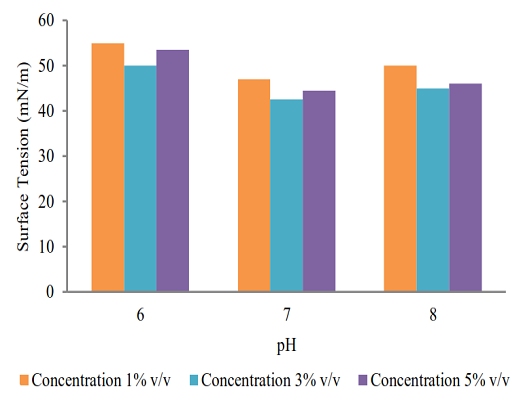Biosurfactant Production from Pseudomonas aeruginosa ATCC27853 with Carbon Source from Crude Palm Oil for Oil Recovery
Abstract
Biosurfactants are surfactants that are synthesized by microorganisms using organic materials and have biodegradable properties, making them environmentally friendly. One of the applications of biosurfactants in the recovery of petroleum. This study aims to determine the type of biosurfactant produced by Pseudomonas aeruginosa bacteria using crude palm oil as the main carbon source, to determine the effect of variations in pH and CPO concentration on surface tension reduction and emulsification, and compare the best biosurfactant with surfactant synthesis. The production of biosurfactants has 3 stages, namely the bacterial preparation, the biosurfactant production, and the analysis in the form of surface tension, emulsification, crude oil removal, and FTIR. The best biosurfactant was obtained at pH 7 and a carbon source concentration of 3% v/v with surface tension and emulsification values of 42.49 mN/m and 58%, respectively. The pH value and CPO concentration can affect the growth in the biosurfactant production process, thus also affecting the surface tension and emulsification values. The biosurfactants obtained were rhamnolipid biosurfactants. The biosurfactants produced in this study have lower crude oil recovery capabilities than synthetic surfactants with crude oil removal values of 57.78% and 79.34%, respectively.
Downloads

Copyright (c) 2022 Said Zul Amraini, Sri Rezeki Muria, Bahruddin Bahruddin, Irdoni HS, Ulfa Dwi Artha, Reno Susanto

This work is licensed under a Creative Commons Attribution-NonCommercial-NoDerivatives 4.0 International License.
Authors who publish with this journal agree to the following terms:
- Copyright on any article is retained by the author(s).
- The author grants the journal, the right of first publication with the work simultaneously licensed under a Creative Commons Attribution License that allows others to share the work with an acknowledgment of the work’s authorship and initial publication in this journal.
- Authors are able to enter into separate, additional contractual arrangements for the non-exclusive distribution of the journal’s published version of the work (e.g., post it to an institutional repository or publish it in a book), with an acknowledgment of its initial publication in this journal.
- Authors are permitted and encouraged to post their work online (e.g., in institutional repositories or on their website) prior to and during the submission process, as it can lead to productive exchanges, as well as earlier and greater citation of published work.
- The article and any associated published material is distributed under the Creative Commons Attribution-NonCommercial-NoDerivatives 4.0 International License.





_copy1.png)










